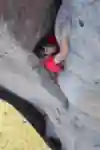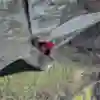Climbing is not about what you do, it's about how you do it. Anyone can grab a rope, some gear, a harness and a bag of chalk, and head up a rock face. But it's the style, form and commitment a climber takes – the 'how' - that defines them.
With much of the lexicon around the sport often sounding as contradictory as it does complex, though, it helps when you have the lingo down. So, to define your how, here's a foolproof guide to climbing style terminology with which to equip yourself ahead of any rocky encounter.
Technique
This is all about what a climber uses to ascend the route – either just using the rock face alone, or using ropes to help them up.
Free climbing
This is often wrongly confused with free soloing, which is a very different and far more insane approach of climbing that is completely free, without a rope.
Free climbing is, in fact, the kind of climbing most people do – using a rope for safety, but not using it as a climbing aid, so not pulling up on it and not even hanging onto it to support their weight.
Aid climbing
This is the opposite of free climbing, where climbers use gear to aid their ascent up a climb, which includes everything from nylon ladders to hand-powered jumars (ascenders), or standing on gear to get up the ropes.
It's often used to bypass sections of rock that are impossible to free climb and would otherwise render the route unclimbable. It's a skill in itself and involves having to place gear quickly in order to move fast and safe.
Tommy Caldwell and Kevin Jorgeson during their free ascent of the Dawn Wall
© Corey Rich/Red Bull Content Pool
Type of climbing
This is about what type of protection a climber chooses to have. For example, a traditionalist might self-install protective equipment on the way up and whip it back out after it's used, while the more cautious will go for fixed bolts. For the free soloists, meanwhile, well, why bother with rope at all?
All types of climbing can either be done with a free or aided technique.
Trad climbing
This is the traditional approach in which climbers must plan the route, place fall protection such as chocks (a metal wedge threaded on a wire used by wedging it into a rock crack) and camming devices (spring-loaded sticks with rotating wheels that open up between cracks) on the way up and then remove them once the pitch is done.
It's extremely technical and highly skillful climbing, with no pre-inspection and no overhead rope protection, and climbers leave no trace behind them.
Sport climbing
Invented in the mid-1980s, sport climbing sees participants using pre-placed safety bolts to clip their safety rope into, rather than screwing, hammering and squeezing in bolts on the way up.
Routes are more defined, like a dot-to-dot puzzle following fixed loops up the rock, and there are anchor points at the top to set a belay. That makes it easier for beginners, but some climbers frown upon permanent bolting.
It requires its own unique focus on flexibility, strength, endurance and sometimes speed – as opposed to the sense of exploration and balance needed in trad climbing.
Bolted trad climbing
OK, so this one's a bit of an oxymoron. Despite trad climbing defined by placing and removing protection as you climb, some trad climbing actually involves using pre-bolted routes.
The difference is that on bolted trad routes, the bolts were placed on lead (on the way up), so are often large distances apart. Bolts on sport routes are set on rappel (the way down) and are far more uniformed.
Simul climbing
Simul climbing is a form of trad climbing that's designed for speed, where two people climb together and the lead climber puts protection in, while the following climber removes it once they're past.
Soloing (aka free soloing)
This is the 'big kahuna' ticket, the type of trad climbing that makes jaws drop and stomachs churn: climbing with no rope for protection. You'll no doubt have seen Alex Honnold conquering El Capitan in the Oscar-winning documentary "Free Solo."
Some say it's the purest form of the sport, others say it's pure insanity. By the number of free soloists who are no longer with us – including Brad Gobright and Austin Howell, who both died in 2019 – the latter is perhaps the more accurate.
Most who do free soloing however say they do it not for the thrill of danger, but for the joy of feeling free and being totally in control.
There are a number of twists on soloing:
- Urban soloing: This involves climbing without ropes up giant buildings or towers. Frenchman Alain Robert – aka Spiderman – was one of the first exponents, but more people are doing it now, thanks to the popularity of the selfie stick.
- Deep water soloing: Essentially free soloing on sea cliffs and stacks. At low levels, this gives a bit of a safety net for a fall, but the higher the climb, the more danger there is from crashing waves and jagged rocks.
- Base soloing: Climbers ascend without ropes, but have a parachute to protect them if they fall. Some say this gives them the confidence to try even more dangerous pitches, while others say it's less pure than unprotected free soloing.
Bouldering
Bouldering 'problems' require strength and the ability to read the rock
© Teddy Morellec/Red Bull Content Pool
The clue is in the name: this is climbing big boulders, from 1.5m to 15m high, and using the most contrary and difficult way to do so. Routes, known as problems, are like a game of chess, involving a short series of powerful, technical moves. There's virtually no equipment required and they can be done alone.
Bouldering areas often have lots of different climbs in one place and are usually low enough to use a crash mat instead of ropes for safety. Highball bouldering takes things higher, adding extra fear of falling.
Roping choice
How you set-up your safety and how far you choose to go defines the roping you need. From basic top-roping to multi-pitch, here are the different options:
Top or bottom roping
This involves having a rope above the climber that's controlled by someone, known as a belayer. They keep the rope tight, so that the climber doesn't fall far if they lose their grip.
Top roping is where the belayer is at the top of the cliff; bottom roping is where the belayer is at the bottom and the safety rope goes through an anchor system at the top, usually fed by trekking up to the top point.
This kind of climbing, which is most used by beginners or indoor climbers, gives a climber confidence to try harder moves and more difficult routes but is limited by rope length.
Lead climbing
This involves two or more climbers in a roped party, with the climber at the top being the lead and wearing a harness attached to a rope, which in turn is connected to the climber, or climbers, below.
The lead attaches the rope to bolts as they go up – either permanent (sport climbing), or self-placed (trad climbing) – while a climber lower down acts as belayer, feeding enough rope to keep the lead climber moving, but safe.
Lead climbers attach the rope to bolts, while the lower climber belays
© Klaus Fengler/Red Bull Content Pool
Multi-pitch climbing
This is lead climbing, but doing more than one pitch at a time, with climbers tying off on the rock face once they run out of rope and then re-rigging to head up the next part of the mountain.
Doing this allows climbers to put together much longer routes and ascend much bigger rock faces, taking multiple days and sleeping on portaledges hanging from the rock face.
Approach
Finally, the level of kudos and self-satisfaction a climber can get from an ascent will depend on how they approached it. For many, the ultimate is just turn up and go, but for more extreme routes, that's just not possible.
So, a super-tough 'redpoint' can be just as cool as a lower grade 'onsight.' Read on to find out more.
Onsight
This is one of the most challenging ways to climb. It involves turning up at a rock face you've never seen or analyzed before, taking a quick look at the route and then climbing it in one non-stop ascent.
Opinions differ on what makes an onsight – some say even just knowing the grade of the route makes the ascent a 'flash' (see below).
Flash
This involves pre-preparation, using what climbers call beta (anything from a guide book description to videos) to gain a good insight into what the climb is likely to involve.
Redpoint or Headpoint
This involves climbing a route (sport for redpoint, trad for headpoint) while lead climbing, having already pre-practiced it before. It's usually done if the route is too challenging to take on as an onsight or flash.
Alex Megos climbs Speed Integrale at Voralpsee in Switzerland
© Thomas Ballenberger/Red Bull Content Pool





















